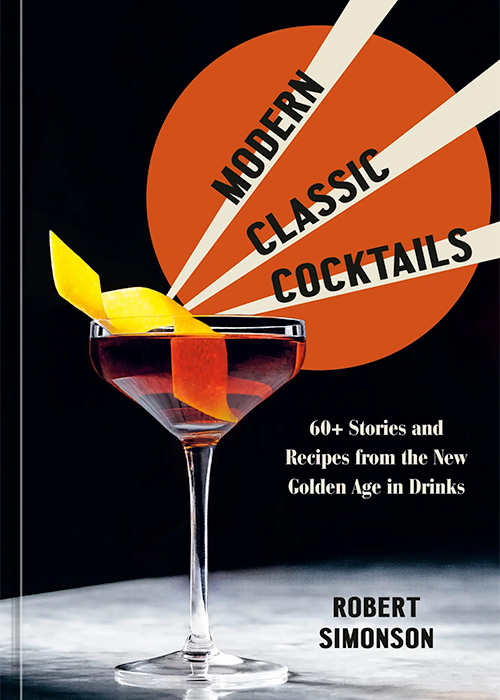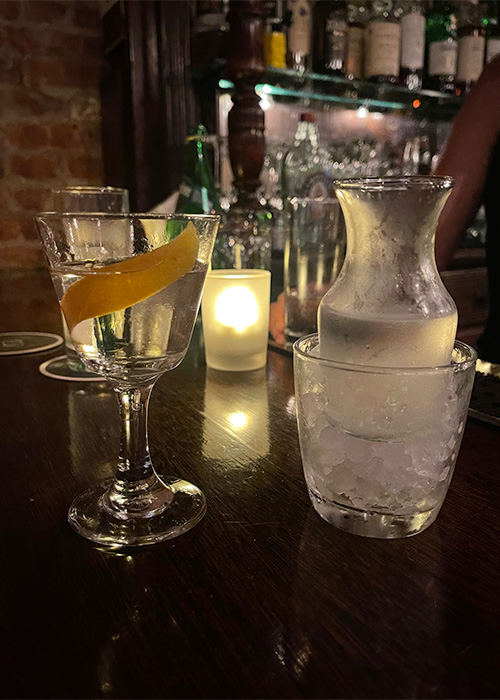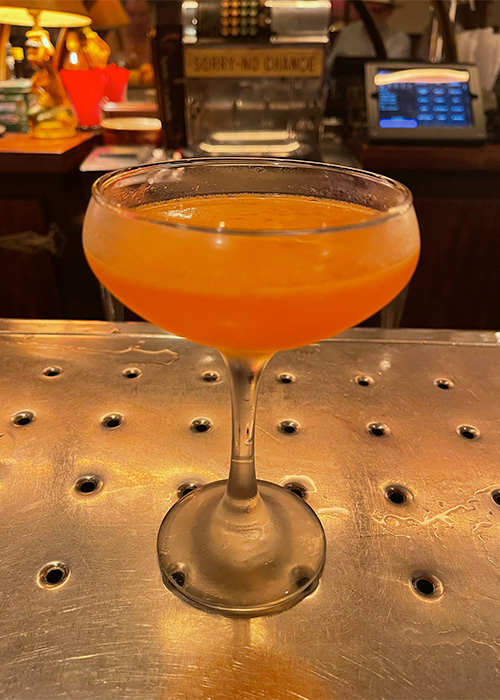While the phrase “modern classic” is inherently a contradiction in terms, it’s the best way to describe the dozens of drinks created in the past 20 to 30 years that have the chance to hang around at the bar long after our final last call. So much of the contemporary cocktail revival began with bartenders and drink enthusiasts diving deep into the past to unearth, celebrate, and sometimes aspire to recreate a pre-Prohibition experience that often seemed like borderline cosplay (so many beards, so many arm garters). But with that movement came a newfound appreciation for classic cocktails like the Old Fashioned, Manhattan, and Martini. Many of the new wave of original drinks that are most likely to stand the test of time, like the Paper Plane and the Oaxaca Old Fashioned, were built from riffs, tweaks, and variations of these old-guard standards and their extended family of universal cocktail templates.
Though he’s a cocktail historian, writer Robert Simonson‘s primary focus is modern history, and his newest book, “Modern Classic Cocktails,” officially out today, serves as an epilogue of sorts to his 2016 “A Proper Drink,” a rich narrative history of the craft cocktail renaissance. For the past decade Simonson has partnered with Martin Doudoroff on their app, Modern Classics of the Cocktail Renaissance, where he’s reached out to these cocktails’ creators to get the exact recipes, details on when and where they were created, and their origin stories. “With the speed and velocity of the current cocktail movement, and with so many important things happening over such a relatively short period of time, it’s important to set down for the record the achievements of the recent past,” says Simonson.

“Modern Classic Cocktails” includes the stories and recipes of 65 drinks, from the Amaretto Sour (Jeffrey Morgenthaler, Clyde Common, Portland, Ore., 2010) to the Winchester (Brian Miller, Elettaria, New York, 2009). Though the book spans the years 1985 to 2013, most cocktails fall between 2005 and 2012, a key period of creativity that Simonson credits to an interconnected bartender community amplified by the internet and social media, national and regional cocktail competitions and conferences, and increased, often brand-supported travel around the world. “These drinks spread very quickly,” he says. “In the past a classic would take forever to become a classic and now it’s, boom, here’s the recipe. And suddenly a drink made in New York is on a menu in Seattle.”
What Makes a Cocktail a Modern Classic?
Like those globe-trotting bartenders banking thousands of frequent-flyer miles, a modern classic cocktail must travel beyond the bar where it was first created. Simonson credits fellow bartenders as the primary movers to help light the spark by adding a peer’s drink to the menu at their own bar. It’s a sign of respect and the creator is sometimes credited on the menu, but more often than not they’re lifted wholesale.
Inevitably, variations on the original abound, from changing the name outright to swapping out ingredients to switching up the serve. Like a cover version of a popular song, there’s a way for a bartender to offer their own spin on the drink while keeping the heart and soul of the original, but it can also risk turning into something unrecognizable. Simonson points out that the deceptively simple spec of the Oaxaca Old Fashioned, created by Phil Ward in 2007, was one of the most “covered” drinks by other bartenders and often appeared on many menus under different names. “It was an early modern classic and it’s also so simple. It’s an Old Fashioned with tequila and mezcal,” says Simonson. “It’s very easy to rip off that model and pass it off as your own; or maybe they think this is so simple they don’t need to credit anybody.”
A Modern Classics Cocktail Crawl
Another perhaps nerdier aspect of modern classic cocktails is that for many of these drinks you can possibly have them made by the creator themselves. Simonson estimates he’s had at least a third of the drinks in the book made by the original bartender over his time writing about drinks, from Dick Bradsell’s Bramble to a Red Hook stirred up by Vincenzo Errico.
With many of the drinks featured in the book born in New York City, I plotted out a neighborhood modern classic cocktail crawl with Simonson, a four-stop evening tour through Brooklyn. Even better, we arranged to have several of the drinks’ creators make their signature cocktails and share some first-hand stories about them.
First Stop: Grand Army (Hard Start)

We settled into our seats at the bar at Grand Army to kick things off with a Hard Start, a drink created by Grand Army co-founder Damon Boelte in 2009 when he was the bar director at the now-shuttered Prime Meats. The drink is technically a shot, equal parts Fernet-Branca and Brancamenta combined in a rocks glass, that Boelte first served to a colleague during a particularly grueling brunch service. Boelte coined its name after the invigorating shot was compared to the sensation of rolling your motorcycle down a hill to manually pop the clutch to keep things moving.
Boelte now lives in Marin County, Calif., but the Hard Start lives on at Grand Army where it’s on the menu paired with a can of Narragansett Light as the house boilermaker, and it’s usually batched in a cheater bottle on the bar to pour out as a shot for those in the know.
Simonson credits the cult status of the Hard Start to its portability, convenience, and the bar world’s obsessions with Fernet. “Damon took this passion to the ultimate level with the Hard Start,” says Simonson. “Any bartender knows what a Hard Start is and if you went into any cocktail bar anywhere across the United States and asked for one, you could get one.”
Rather than a shot I typically have mine in a chilled rocks glass like an after-dinner sipper, and that’s how the bartender presented them to us at Grand Army. I texted Boelte to see if, for the proper Hard Start experience, we should shoot them back or sip them chilled. His response: “Either way works. You do you, man!”
Second Stop: Leyenda (Tia Mia)

Reinvigorated by our Hard Starts, we stopped by to see Ivy Mix, co-owner of Leyenda and the bottle shop Fiasco! as well as co-founder of Speed Rack and author of the award-winning “Spirits of Latin America.” She met us at Leyenda to personally shake up her modern classic, the Tia Mia, a mezcal-spiked Mai Tai variation that first appeared on the menu at Julie Reiner’s tiki-inspired bar Lani Kai in 2010. It found a new home on the opening menu of Leyenda in 2015 where it’s remained one of the top five best-selling drinks ever since.
At that time, more expressions of mezcal were starting to become readily available in the States and Mix was in the habit of serving a little copita of Del Maguey Chichicapa Mezcal as a floater for Reiner’s house Mai Tai, made with a split base of agricole and Jamaican rum, Curaçao, and toasted almond orgeat. “It was a little treat for my regulars but it got me thinking about the possibilities of pairing mezcal with agricole,” says Mix. She chose Appleton Estate Reserve Jamaican rum as it wasn’t too aggressive but still possessed a bit of funk.

The Tia Mia has since appeared in at least a half-dozen different cocktail books and on menus around the world. “Someone recently sent me a photo of it on the menu at a place in San Antonio, but it’s never credited. Never,” says Mix. “The intellectual property of cocktail recipes is a vast, vast thing, but that’s a topic for another day.” Mix notes that she’d almost rather not have her name on someone else’s menu as that version of her drink might not be up to her standards.
“I’m trying to think of the last time I personally made this drink for someone when It wasn’t just for a photograph,” says Mix, sliding two Tia Mias in front of us along with two copitas. “It’s been a long time.”
Third Stop: Clover Club (Gin Blossom, The Slope)

Mix tagged along with us as we crossed the street over to Clover Club to say hello to Julie Reiner. In addition to Clover Club and Leyenda, Reiner is one of the new owners of Milady’s, the beloved former Soho dive bar that’s set to reopen this month. She is also the author of “The Craft Cocktail Party” and stars in the upcoming Netflix series “Drink Masters.”
Reiner has been set up at a corner of the bar at Clover Club the past few weeks field testing drinks that will soon debut at Milady’s, but she invited us to post up and join her. It reminded her of when she was working out of the Flatiron Lounge developing drinks for the opening of Clover Club in 2008, including the Gin Blossom and The Slope, two modern classics she was preparing to stir up for us. When I asked her what the secret was to creating a modern classic cocktail, without missing a beat she said with a big laugh, “Put it on the menu and never take it off.”

Eric Seed of the importer Haus Alpenz was frequently coming by Flatiron Lounge and would ask Reiner what products she wished were available stateside. He would then bring samples for her and the staff to try, and one key flavor component that resonated with Reiner was apricot, in the form of an eau-de-vie that would find a home in the Gin Blossom and a liqueur in The Slope.

“I thought it would be cool to have a house Martini and a house Manhattan variations that kind of spoke to each other,” says Reiner. “The apricot was key. It was the tie-in to connect the two drinks.” Both were popular right out of the gate and have not left the menu ever since Clover Club opened. “These are classic recipes, classic specs but they’re unique to our location and became signature drinks,” says Reiner. “But they’re different enough to each stand out on their own.”
Fourth Stop: The Long Island Bar (Oaxaca Old Fashioned, Division Bell, Cosmopolitan)

The last stop of our neighborhood crawl was Long Island Bar, where Phil Ward was behind the bar and agreed to make us two of his creations, the Oaxaca Old Fashioned and the Division Bell.
“If you want your drink to become a modern classic it needs to be two things,” says Ward. “It needs to be good, and it needs to be a drink every bartender can make. It can’t call for unicorn tears or a tincture made from elf farts.”
Ward went to work building an Oaxaca Old Fashioned, his most famous drink and perhaps one of the best known of the modern classics. The first bartender’s choice he shook up on the fly in 2007 at Death & Co. was a Jovencourt Daiquiri for Lynnette Marrero, adding a quarter-ounce of mezcal to a traditional Daiquiri spec. “I thought, what the fuck is going here?” says Ward. “How can this be so good with only a quarter-ounce of mezcal?”

Ward had a cast of regulars who served as guinea pigs for new drinks they were constantly playing around with and later that week one lucky customer received the very first Oaxaca Old Fashioned. “There was no R&D on that one. It was perfect,” says Ward. The drink took off and became a mainstay at Ward’s tequila and mezcal bar Mayahuel.
Next up was the Division Bell, another mezcal-based modern classic Ward created at Mayahuel in 2009, made with Del Maguey Vida, Aperol, maraschino, and lime. “I love the Division Bell,” says Ward.” It’s one of my fondest drinks and I’m fonder of this than almost all my children.” Though the inspiration for the drink came out of a period of anxious distress during the months of building out the Mayahuel space.
Annoyed by all the delays and construction-related red tape, Ward focused on one last task — staining 3,000 square feet of walls, floors, and woodwork. “I just loved when the pain-in-the-ass construction workers left and the hectic day was over. I’d go over to the bodega, grab a 6-pack of beer, turn on the tunes, smoke a little doobie, and just stain stuff for hours,” says Ward. The album he listened to the most during these staining sessions was Pink Floyd’s “Division Bell.”
“Everybody always tries to say that everything’s been done before,” says Ward. “I liked tequila a lot but when I started making tequila drinks at that time, if you did anything new with tequila it wasn’t actually new. I was just putting tequila into existing templates to see what would happen. Everything is templates and balance.”
Long Island Bar owner Toby Cecchini was out of town, but Ward agreed to make us Cecchni’s contribution to the modern classic cocktail canon, the Cosmopolitan. Created in 1988 at the Odeon in Tribeca. Simonson calls the Cosmo a “proto-classic,” saying, “It’s not part of the cocktail revival, but it certainly fed into it and showed that a modern cocktail could be created that would stand the test of time.”
The pink-hued mix of Absolut Citron, Cointreau, Ocean Spray Cranberry Juice Cocktail, and lime experienced external factors (namely being a heavily featured favorite drink of Carrie Bradshaw on “Sex and the City” a decade after Cecchini first made the drink) that helped catapult the cocktail from a house drink known among the Odeon staff and influential regulars to international sensation.

“Nobody likes something that is ordered too much, especially if they don’t take it seriously,” says Ward. “The same thing that happened to the Cosmo happened to the Mojito. Everybody made it and so many people made really bad ones. Toby created such a good fucking drink but nobody made it as well, so naturally bartenders started to hate it.”
Nightcap
Before parting ways I ask Simonson if he thinks we’ll see a future generation of modern classics from the new school of bartenders on the scene. “You never know what’s going to happen, but I’m rather doubtful,” he says. “There was a perfect kind of chrysalis for a while where you had people crazy about making cocktails and this big blank slate as nothing too much had been done creatively for 30 years. I believe every drink in the book will go through cycles. Some will rise again in popularity and others could just fall off the face of the earth and become a historical footnote we look back at as a curiosity.”
